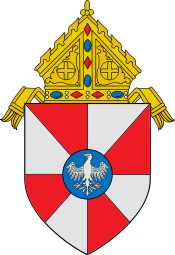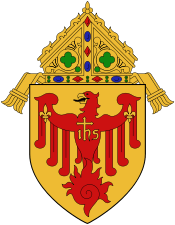Albert Gregory Meyer
| His Eminence Albert Gregory Meyer | |
|---|---|
| Cardinal, Archbishop of Chicago | |
 | |
| See | Chicago |
| Appointed | September 19, 1958 |
| Installed | November 16, 1958 |
| Term ended | April 9, 1965 |
| Predecessor | Samuel Stritch |
| Successor | John Cody |
| Other posts | Cardinal-Priest of Santa Cecilia in Trastevere |
| Orders | |
| Ordination |
July 11, 1926 by Basilio Pompilj |
| Consecration |
April 11, 1946 by Moses E. Kiley |
| Created Cardinal |
December 14, 1959 by John XXIII |
| Rank | Cardinal-Priest |
| Personal details | |
| Born |
March 9, 1903 Milwaukee, Wisconsin |
| Died |
April 9, 1965 (aged 62) Chicago, Illinois |
| Previous post |
|
| Motto |
ADVENIAT REGNUM TUUM (THY KINGDOM COME) |
| Coat of arms |
 |
| Styles of Albert Meyer | |
|---|---|
 | |
| Reference style | His Eminence |
| Spoken style | Your Eminence |
| Informal style | Cardinal |
| See | Chicago |
Albert Gregory Meyer (March 9, 1903 – April 9, 1965) was an American prelate of the Roman Catholic Church who served as the Archbishop of the Archdiocese of Chicago from 1958 until his death in 1965, and was appointed a cardinal in 1959.
Early life and education
Albert Meyer was born in Milwaukee, Wisconsin, to Peter James and Mathilda (née Thelen) Meyer, who were German immigrants.[1] The fourth of five children, he had two brothers and two sisters; one sister became a nun.[2][3] As a child, Meyer would pretend to say Mass with a toy altar and a glass of water for the chalice of wine.[3]
He received his early education under the School Sisters of Notre Dame at the parochial school of St. Mary's Church.[2] After attending Marquette Academy for two years, he entered St. Francis Seminary.[1] In 1922, he was sent by Archbishop Sebastian Gebhard Messmer to continue his studies at the Pontifical North American College in Rome.[2]
Priesthood
On July 11, 1926, Meyer was ordained to the priesthood by Cardinal Basilio Pompilj, at the church of Santa Maria sopra Minerva.[4] He then studied at the Pontifical Biblical Institute, from where he obtained a doctorate in Holy Scriptures in 1930.[1]
Upon returning to the United States, he served as a curate at St. Joseph's Church in Waukesha until 1931, when he became a professor at his alma mater of St. Francis Seminary.[2] He there taught religion, Greek, Latin, biblical archeology, dogmatic theology and Holy Scriptures.[1] When Aloisius Joseph Muench was named Bishop of Fargo, Meyer succeeded him as rector of St. Francis Seminary in 1937.[1] He was raised to the rank of Domestic Prelate in 1938, and also served as a chaplain and adviser to the Serra Club.[2]
Bishop of Superior, Wisconsin
On February 18, 1946, he was appointed the sixth bishop of the Diocese of Superior, Wisconsin by Pope Pius XII.[5] Meyer was consecrated on the following April 11 by Archbishop Moses E. Kiley, with Bishops Aloisius Joseph Muench and William Patrick O'Connor serving as co-consecrators, in the Cathedral of St. John the Evangelist.
Archbishop of Milwaukee and Chicago
Bishop Meyer became the seventh Archbishop of Milwaukee on July 21, 1953. He was installed as Archbishop of Chicago on November 16, 1958.[6]
When Meyer visited the victims of the Our Lady of the Angels School fire with then-Mayor Daley, he nearly collapsed with grief while visiting the hospital and morgue. Cardinal Francis Spellman, archbishop of New York, lent support by travelling to Chicago in the aftermath of this tragedy, and Pope John XXIII sent a telegram to Meyer.
Cardinal
Despite skepticism,[7] Meyer was created Cardinal Priest of S. Cecilia by Pope John XXIII in the consistory of December 14, 1959. He later participated at the first three sessions of the Second Vatican Council, from 1962 to 1964, and sat on its Board of Presidency. During the Council, Meyer showed himself to be of liberal tendencies[8][9][10] and was viewed as the chief intellectual among the participating American hierarchy.[11] The scholarly and often shy prelate supported religious liberty,[12] and strongly condemned racism, giving speeches alongside Martin Luther King, Jr. and warning his clergy "not to foster the flame of racial hatred".[11] Meyer was also one of the cardinal electors in the 1963 papal conclave, which selected Pope Paul VI. Meyer, an occasional fisher, once called fishing the "apostolic recreation", and was also known to attend a Milwaukee Braves baseball game.[13]
Death
He served as Archbishop of Chicago until his death from a heart attack after an operation to remove a malignant brain tumor in Mercy Hospital at age 62. He is buried in the cemetery of the University of Saint Mary of the Lake in Mundelein, Illinois.
See also
References
- 1 2 3 4 5 Miranda, Salvador. "MEYER, Albert Gregory". The Cardinals of the Holy Roman Church.
- 1 2 3 4 5 Thornton, Francis. "Albert Cardinal Meyer". Our American Princes.
- 1 2 "Stritch's Successor". TIME Magazine. October 6, 1958.
- ↑ "Albert Gregory Cardinal Meyer". Catholic-Hierarchy.org.
- ↑ Diocese of Superior. Bishop Meyer (1946-1953).
- ↑ Archdiocese of Milwaukee. Archbishop Albert Gregory Meyer
- ↑ TIME Magazine. Pope's Progress December 1, 1958
- ↑ TIME Magazine. The Council's Prospects September 14, 1962
- ↑ TIME Magazine. Cum Magno Dolore October 23, 1964
- ↑ TIME Magazine. The Pope Runs the Church November 27, 1964
- 1 2 Holy Name Cathedral Parish. Resurrection, Restore & Renew April 8, 2007 Archived April 30, 2007, at the Wayback Machine.
- ↑ TIME Magazine. The Right to Worship According to One's Conscience October 2, 1964
- ↑ TIME Magazine. Stritch's Successor October 6, 1958
External links
| Catholic Church titles | ||
|---|---|---|
| Preceded by Samuel Stritch |
 Archbishop of Chicago 1958–1965 |
Succeeded by John Cody |
| Vacant Title last held by Gaetano Cicognani |
Cardinal-Priest of Santa Cecilia in Trastevere 1959 – 1965 |
Vacant Title next held by John Cody |
| Preceded by Moses E. Kiley |
 Archbishop of Milwaukee 1953–1958 |
Succeeded by William Cousins |
| Preceded by William Patrick O'Connor |
 Bishop of Superior 1946–1953 |
Succeeded by Joseph John Annabring |
